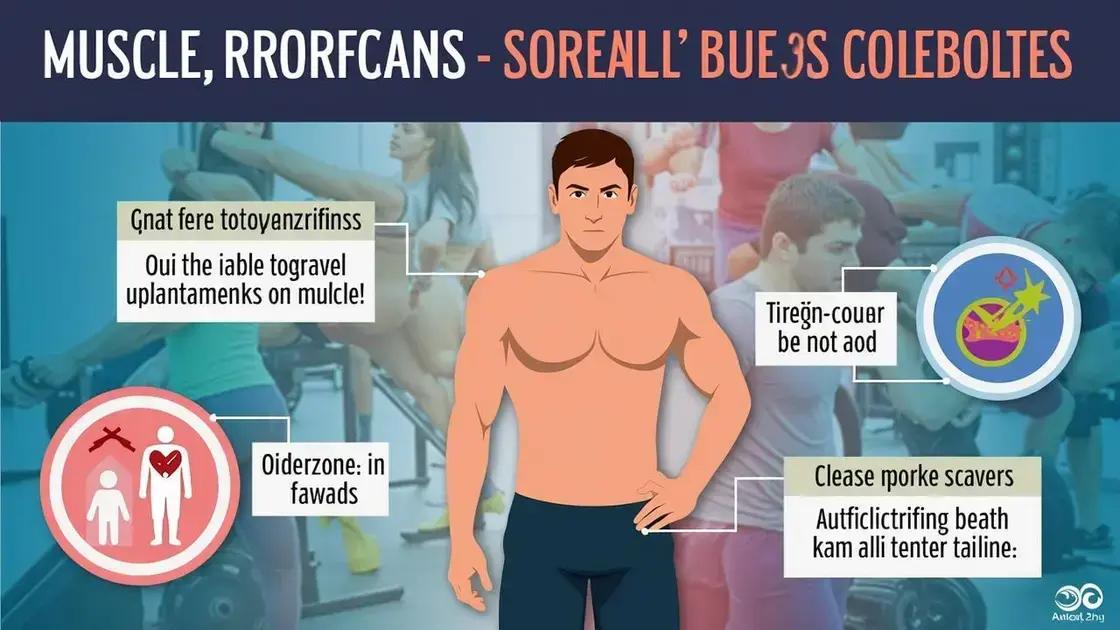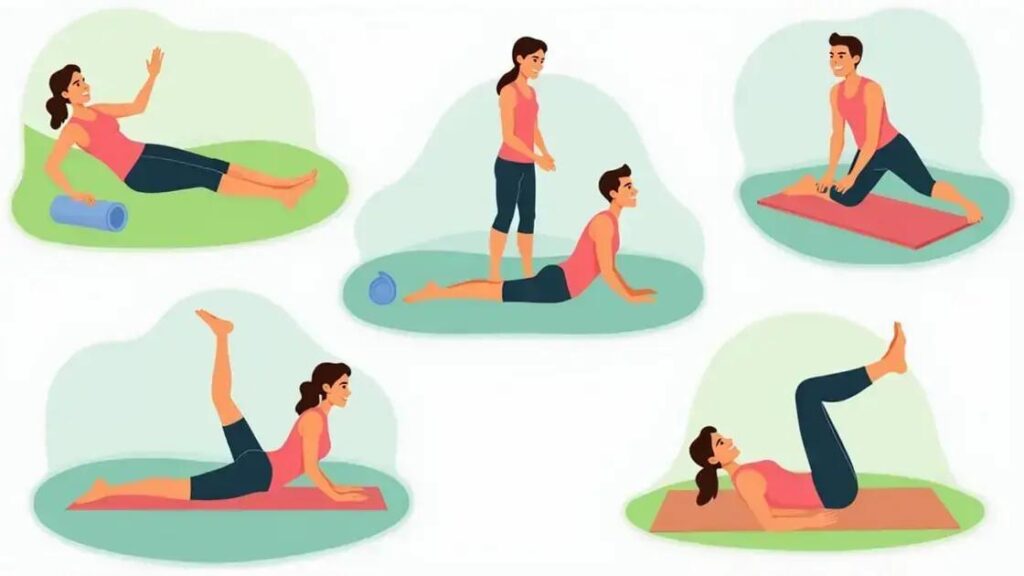The best recovery exercises for sore muscles include low-impact activities like walking, swimming, and yoga, alongside effective stretching techniques and proper hydration and nutrition, all of which help alleviate soreness and promote quicker recovery.
Are you struggling with sore muscles after workouts? Discover the best recovery exercises for sore muscles that can help you feel better fast! Incorporating these effective techniques into your routine can speed up your recovery and minimize discomfort. From stretching to low-impact exercises, we’ll explore how each method plays a critical role in muscle recovery and overall well-being.
Understanding Muscle Soreness

Muscle soreness is a common experience for anyone engaging in physical activity. It usually occurs after intense workouts and is known as delayed onset muscle soreness (DOMS). Understanding muscle soreness is essential for effective recovery. When you push your muscles beyond their usual limits, tiny tears occur in the muscle fibers. This triggers inflammation and the sensation of soreness.
Causes of Muscle Soreness
Muscle soreness can arise from several factors. Overexertion during exercise is the primary cause. When you increase the intensity, duration, or type of your exercise, your muscles may react with soreness. Moreover, new activities that your body isn’t accustomed to can shock the system and lead to soreness.
Impact on Recovery
While discomfort can be a sign of a good workout, it is essential to listen to your body. Acknowledging soreness helps you plan your recovery exercises effectively. Allowing time for recovery is crucial, as it can influence your performance in future workouts. Neglecting to address soreness can lead to injuries.
Benefits of Understanding Muscle Soreness
Indeed, recognizing why your muscles are sore is beneficial. It empowers you with knowledge to manage recovery better. Incorporating recovery exercises and strategies can minimize discomfort, help rebuild muscle strength, and improve overall performance. Understanding your body’s signals allows for a balanced workout routine that includes rest, recovery, and growth.
Effective Stretching Techniques

Effective stretching techniques are crucial for muscle recovery, especially after a workout. They help enhance flexibility, reduce soreness, and improve overall performance. Here are some of the best stretching methods to incorporate into your recovery routine.
Static Stretching
Static stretching involves holding a stretch for a specific period, usually between 15 to 30 seconds. It’s best performed after a workout, as it helps relax the muscles. Common static stretches include hamstring stretches, where you sit and reach for your toes, and quadriceps stretches, where you pull your ankle towards your glutes while standing.
Dynamic Stretching
Dynamic stretching is a more active form that involves moving through stretches. This method warms up the muscles and prepares them for further activity. Examples include leg swings, where you swing your legs forward and backward, and arm circles, which help warm up your upper body.
Foam Rolling
Foam rolling is a self-myofascial release technique that helps relieve muscle tightness and soreness. By applying pressure to specific areas, you can alleviate discomfort. Focus on problem areas like your back, thighs, and calves. Spend about 1-2 minutes rolling each muscle group.
Incorporating Stretching into Your Routine
To gain the benefits of stretching, it’s essential to keep it a regular part of your routine. Aim for at least 10-15 minutes of stretching after workouts. Additionally, consider scheduling dedicated stretching sessions on rest days to promote recovery. Remember, consistency is key to improved flexibility and reduced soreness.
Low-Impact Recovery Exercises

Low-impact recovery exercises play a vital role in soothing sore muscles while preventing further injury. These movements are gentle and effective, making them suitable for anyone, especially after intense workouts. Here are several low-impact exercises you can incorporate into your routine.
Walking
A simple yet effective low-impact activity is walking. A gentle walk can help promote blood flow and aid muscle recovery. Aim for a pace that feels comfortable, and try to walk for at least 15-30 minutes.
Swimming
Swimming is another excellent low-impact exercise. The water supports your body, reducing strain on your muscles and joints. Different strokes can target various muscle groups while providing a refreshing way to recover. Aim for a leisurely pace that feels good to you.
Biking
Cycling, whether on a stationary bike or outdoors, offers a great cardio workout without stressing sore muscles. Adjust the resistance to suit your comfort level. Focus on maintaining a steady pace for 20-30 minutes to promote circulation while allowing your muscles to recover.
Yoga
Gentle yoga can help alleviate muscle soreness while improving flexibility and relaxation. Poses like Child’s Pose and Cat-Cow Stretch are particularly beneficial. Consider a restorative yoga class focused on deep stretching and breathing.
Pilates
Pilates emphasizes core strength and flexibility with controlled movements. Many Pilates exercises are low-impact and promote recovery. Focus on deep breathing and slow movements to enhance relaxation and range of motion.
Importance of Hydration and Nutrition

Staying properly hydrated and maintaining good nutrition are crucial for muscle recovery. When you exercise, your body loses fluids and essential nutrients, which can lead to fatigue and soreness. Let’s explore the importance of hydration and nutrition in the recovery process.
Hydration
Water plays a vital role in muscle recovery. It helps transport nutrients to your muscles and flushes out waste products. When you are dehydrated, you may experience increased muscle fatigue and slower recovery times. Aim to drink at least 8-10 glasses of water daily, and consider more during intense workouts.
Electrolytes
Along with water, electrolytes are important for maintaining hydration. Electrolytes like sodium, potassium, and magnesium help regulate muscle function. You can replenish them through sports drinks or natural sources like coconut water and fruits. Staying balanced in electrolytes will aid in muscle recovery and prevent cramps.
Nutrition
Nutrition is another key component of recovery. Eating a well-balanced diet rich in proteins, healthy fats, and carbohydrates supports muscle repair. Protein is essential for rebuilding muscle fibers, while carbohydrates provide energy for your next workout. Include sources like lean meats, fish, nuts, and whole grains in your meals.
Post-Workout Meals
After exercising, focus on a healthy post-workout meal to enhance recovery. Aim to eat within 30-60 minutes after your workout. Good options include a protein shake with fruit, yogurt with granola, or a chicken salad with mixed greens. These meals help replenish glycogen stores and support muscle repair.
In conclusion, effective recovery is key to achieving your fitness goals
Incorporating the best recovery exercises for sore muscles, understanding muscle soreness, utilizing effective stretching techniques, engaging in low-impact workouts, and prioritizing hydration and nutrition are all critical for optimal recovery.
By taking care of your body and allowing it the time it needs to heal, you’ll not only improve your performance but also prevent injuries in the long run.
Make recovery a regular part of your fitness routine, and you’ll surely see the positive impact on your overall health and physical capabilities.
FAQ – Frequently Asked Questions about Recovery Exercises and Muscle Soreness
What are the best recovery exercises for sore muscles?
The best recovery exercises include walking, swimming, cycling, yoga, and Pilates, which promote circulation and help alleviate soreness.
How does hydration impact muscle recovery?
Hydration is crucial for muscle recovery as it helps transport nutrients to muscles and flushes out toxins, reducing soreness and fatigue.
What role does nutrition play in recovery?
Proper nutrition, including proteins, healthy fats, and carbohydrates, is essential for repairing muscle fibers and replenishing energy stores after a workout.
What is delayed onset muscle soreness (DOMS)?
DOMS is the muscle pain and stiffness that often occurs after intense or unfamiliar exercise, usually peaking 24 to 72 hours post-exercise.
How can stretching help with muscle soreness?
Stretching can help improve flexibility, increase blood flow, and reduce tightness in sore muscles, aiding in recovery.
When should I perform recovery exercises?
Aim to perform recovery exercises within 30 minutes after a workout and continue to include them in your routine for several days post-exercise.












